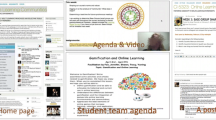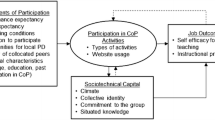Abstract
Using a quasi-experimental, nonequivalent pretest/posttest control group design, the researchers examined the effects of online collaborative learning on eighth-grade student’s sense of community in a physical science class. For a 9-week period, students in the control group participated in collaborative activities in a face-to-face learning environment, whereas students in the experimental group participated in online collaborative activities using the Edmodo educational platform in a hybrid learning environment. Students completed the Classroom Community Scale survey as a pretest and posttest. Results indicated that the students who participated in the face-to-face classroom had higher overall sense of community and learning community than students who participated in collaborative activities in the online environment. Results and implications are discussed and suggestions for future research are provided.


Similar content being viewed by others
References
Abfalter D, Zaglia ME, Mueller J (2012) Sense of virtual community: a follow up on its measurement. Comput Hum Behav 28(2):400–404
Admiraal W, Lockhorst D (2012) The Sense of Community in School Scale (SCSS). J Workplace Learn 24(4):245–255. doi:10.1108/13665621211223360
Ahern TC, Thomas JA, Tallent-Runnels MK, Lan WY, Cooper S, Lu X, Cyrus J (2006) The effect of social grounding on collaboration in a computer-mediated small group discussion. Internet High Educ 9:37–46
Anderson CW (2007) Perspectives on science learning. In: Abell SK, Lederman NG (eds) Handbook of research on science education. Routledge, New York, pp 3–30
Baker PH, Murray MM (2011) Building community partnerships: learning to serve while learning to teach. Sch Commun J 21(1):113–127
Bluic A, Ellis R, Goodyear P, Piggott L (2010) Learning through face-to-face and online discussions: associations between students’ conceptions, approaches, and academic performance in political science. Br J Educ Technol 41(3):512–524
Borup J, Graham CR, Davies RS (2012) The nature of adolescent learner interaction in a virtual high school setting. J Comput Assist Learn 29:153–167
Buraphadeja V, Kumnuanta J (2011) Enhancing the sense of community and learning experience using self-paced instruction and peer tutoring in a computer-laboratory course. Australas J Educ Technol 27(8):1338–1355
Bye L, Smith S, Rallis HM (2009) Reflection using an online discussion forum: impact on student learning and satisfaction. Soc Work Educ 28(8):841–855
Cameron BA, Morgan K, Williams KC, Kostelecky KL (2009) Group projects: student perceptions of the relationship between social tasks and a sense of community in online group work. Am J Distance Educ 23(1):20–33
Campbell DT, Stanley JC (1963) Experimental and quasi-experimental designs for research. Houghton Mifflin Company, Boston
Chen W, Looi Ch, Tan S (2010) What do students do in a F2F CSCL classroom? The optimization of multiple communications modes. Comput Educ 55(3):1159–1170
Chiessi M, Cicognani E, Sonn C (2010) Assessing sense of community on adolescents: validating the brief scale of Sense of Community in adolescents (SOC-A). J Commun Psychol 38(3):276–292
Clark RC, Mayer RE (2011) e-learning and the science of instruction. Pfeiffer, San Francisco
Conrad R, Donaldson JA (2004) Engaging the online learner. Jossey-Bass, San Francisco
DeWitt D, Siraj S, Alias N (2014) Collaborative mLearning: a module for learning secondary school science. Educ Technol Soc 17(1):89–101
Dewiyanti S, Brand-Gruwel S, Jochems W, Broers NJ (2007) Students’ experiences with collaborative learning in asynchronous computer-supported collaborative learning environments. Comput Hum Behav 23(1):496–514
Donne V (2012) Wiki: using the web connections to connect students. TechTrends 56(2):31–36
Evans SD (2007) Youth sense of community: voice and power in community contexts. J Commun Psychol 35(6):693–709
Ferreira MM, Trudel AR (2012) The impact of problem-based learning (PBL) on student attitudes toward science, problem-solving skills, and sense of community in the classroom. J Classr Interact 47(1):23–30
Fraser BJ (2007) Classroom learning environments. In: Abell SK, Lederman NG (eds) Handbook of research on science education. Routledge, New York, pp 103–124
Garrison DR, Arbaugh JB (2007) Researching the community of inquiry framework: review, issues, and future directions. Internet High Educ 10(3):157–172
Garrison DR, Cleveland-Innes M (2005) Facilitating cognitive presence in online learning: interaction is not enough. Am J Distance Educ 19(3):133–148
Garrison DR, Anderson T, Archer W (2001) Critical thinking, cognitive presence, and computer conferencing in distance education. Am J Distance Educ 15(1):7–23
Glynn TJ (1981) Psychological sense of community: measurement and application. Hum Relat 34(9):780–818
Goodings L, Locke A, Brown SD (2007) Social networking technology: place and identity in mediated communities. J Commun Appl Soc Psychol 17(6):463–476
Kanuka H, Rourke L, Laflamme E (2007) The influence of instructional methods on the quality of online discussion. Br J Educ Technol 38(2):260–271
Kelly GJ (2007) Discourse in science classrooms. In: Abell SK, Lederman NG (eds) Handbook of research on science education. Routledge, New York, pp 443–469
Kelly C (2011) A critical pedagogy of cafeterias and communities: the power of multiple voices in diverse settings. Middle Grades Res J 6(2):97–111
Keser H, Uzunboylu H, Ozdamli F (2011) The trends in technology supported collaborative learning studies in 21st century. World J Educ Technol 3(2):103–119
Koh MH, Hill JR (2009) Student perceptions of group work in an online course: benefits and challenges. J Distance Educ 23(2):69–92
Kwon K, Liu Y, Johnson LP (2014) Group regulation and social-emotional interactions observed in computer supported collaborative learning: comparison between good vs. poor collaborators. Comput Educ 78:185–200
Larkin D (2012) Misconceptions about ‘misconceptions’: preservice secondary science teachers’ views on the value and role of student ideas. Sci Educ 96(5):927–959
Lunetta VN, Hofstein A, Clough MP (2007) Learning and teaching in the school of science laboratory: an analysis of research, theory, and practice. In: Abell SK, Lederman NG (eds) Handbook of research on science education. Routledge, New York, pp 393–441
McIsaac MS, Gunawardena CN (1996) Distance education. In: Jonassen DH (ed) Handbook of research for educational communications and technology: a project of the Association for Educational Communications and Technology. Simon & Schuster Macmillan, New York, pp 403–437
McMillan DW, Chavis DM (1986) Sense of community: a definition and theory. J Commun Psychol 14(1):6–23
Miller RL, Benz JJ (2008) Techniques for encouraging peer collaboration: online threaded discussion or fishbowl interaction. J Instr Psychol 35(1):87–93
Minocha S (2009) Role of social software tools in education: a literature review. Educ Train 51(5/6):353–369
NGSS Lead States (2013) Next generation science standards. The National Academies Press, Washington
Nuankhieo P, Tsai I, Goggins S, Laffey J (2007) Comparing the social interaction pattern of online one-on-one peer and small group collaboration activities. In: Ninth IEEE international symposium on multimedia 2007, 441–446. doi:10.1109/ISM.Workshops.2007.80
Ouzts K (2006) Sense of community in online courses. Q Rev Distance Educ 7(3):285–296
Palloff RM, Pratt K (1999) Building learning communities in cyberspace. Jossey-Bass Publishers, San Francisco
Parveen Q, Batool S (2012) Effect of cooperative learning on achievement of students in general science at secondary level. Int Educ Stud 5(2):154–158
Pugh MJV, Hart D (1999) Identity development and peer group formation. New Dir Child Adolesc Dev 1999(84):55–70
Reich SM (2010) Adolescents’ sense of community on Myspace and Facebook: a mixed-methods approach. J Commun Psychol 38(6):688–705
Ronsisvalle T, Watkins R (2005) Student success in online K-12 education. Q Rev Distance Educ 6(2):117–124
Rossi RJ (1997) Serving rural youth at risk: a portrait of collaboration and community. J Educ Stud Placed Risk 2(3):213–227
Rovai AP (2002a) Development of an instrument to measure classroom community. Internet High Educ 5(3):197–211
Rovai AP (2002b) Sense of community, perceived cognitive learning, and persistence in asynchronous learning networks. Internet High Educ 5(4):319–322
Rovai AP, Wighting MJ, Lucking R (2004) The classroom and school community inventory: development, refinement, and validation of a self-report measure for educational research. Internet High Educ 7(4):263–280
Rovai AP, Baker JS, Ponton MK (2013) Social science research design and statistics: a practitioner’s guide to research methods and SPSS analysis. Watertree Press, Chesapeake
Roxas K (2011) Creating communities: working with refugee students in classrooms. Democr Educ 19(2):1–8
Sancho M, Cline T (2012) Fostering a sense of belonging and community as children start a new school. Educational & Child Psychology 29(1):64–74
Schulte LE, Shanahan S, Anderson TD, Sides J (2003) Student and teacher perceptions of their middle and high schools’ sense of community. Sch Commun J 13(1):7–33
Scott P, Asoko H, Leach J (2007) Student conceptions and conceptual learning in science. In: Abell SK, Lederman NG (eds) Handbook of research on science education. Routledge, New York, pp 31–56
Shamah D (2011) Supporting a strong sense of purpose: lessons from a rural community. New Dir Youth Dev 2011(132):45–58
Shea P, Li CS, Pickett A (2006) A study of teaching presence and student sense of learning community in fully online and web-enhanced college courses. Internet High Educ 9(3):175–190
Songer NB (2007) Digital resources versus cognitive tools: A discussion of learning science with technology. In: Abell SK, Lederman NG (eds) Handbook of research on science education. Routledge, New York, pp 471–491
Tabachnick BG, Fidell LS (2013) Using multivariate statistics. Pearson, Boston
Tan W, Tan C, Teo H (2012) Conveying information effectively in a virtual world: insights from synthesized task closure and media richness. J Am Soc Inform Sci Technol 63(6):1198–1212
Thomas MJW (2002) Learning within incoherent structures: the space of online discussion forums. J Comput Assist Learn 18(3):351–366
Top E (2012) Blogging as a social medium in undergraduate courses: sense of community best predictor of perceived learning. Internet High Educ 15(1):24–28
Townley G, Katz J, Wandersman A, Skiles B, Schillaci MJ, Timmerman BE, Mousseau TA (2013) Exploring the role of sense of community in the undergraduate transfer student experience. J Commun Psychol 41(3):277–290
Treagust DF (2007) General instructional methods and strategies. In: Abell SK, Lederman NG (eds) Handbook of research on science education. Routledge, New York, pp 373–391
Tu C (2002) The measurement of social presence in an online learning environment. Int J e-Learn 1(2), 34–45. Retrieved from http://www.aace.org/dl/files/IJEL/IJEL1234.pdf
Tu C, Corry M (2002) eLearning community. Q Rev Distance Educ 3(2):207–218
Tutty JE, Klein JD (2008) Computer-mediated instruction: a comparison of online and face-to-face collaboration. Educ Technol Res Dev 56(2):101–124
Vaughan N, Garrison DR (2005) Creating cognitive presence in a blended faculty development community. Internet High Educ 8(1):1–12
Virginia Department of Education (2010) Physical science. Retrieved from http://www.doe.virginia.gov/testing/sol/standards_docs/science/2010/courses/stds_physical_science.pdf
Vygotsky LS (1978) Mind in society: the development of higher psychological processes. Harvard University Press, Cambridge
Vygotsky LS (1986) Thought and language. MIT Press, Cambridge
Wendt JL, Rockinson-Szapkiw A (2014) The effect of collaboration on middle school student science misconceptions as an aspect of science literacy. J Res Sci Teach 51(9):1103–1118
Wenger E (1998) Communities of practice: learning, meaning, and identity. Cambridge University Press, Cambridge
Wighting M, Nisbet D, Spaulding L (2009) Relationships between sense of community and academic achievement: a comparison among high school students. Int J Humanit 7(3):63–72
Wighting M, Nisbet D, Rockinson-Szapkiw AJ (2013) Measuring sense of community and academic learning in graduate education. Interdiscip Educ Stud 7(1):1–8
Winters FI, Alexander PA (2011) Peer collaboration: the relation of regulatory behaviors to learning with hypermedia. Instr Sci 39(4):407–427
Yang C, Chang YS (2012) Assessing the effects of interactive blogging on student attitudes toward peer interaction, learning motivation, and academic achievements. J Comput Assist Learn 28(1):126–135
Yu AY, Tian SW, Vogel D, Kwok RC (2010) Can learning be virtually boosted? An investigation of online social networking impacts. Comput Educ 55(1):1494–1503
Zhao Y, Alvarez-Torres MJ, Smith B, Tan HS (2004) The non-neutrality of technology: a theoretical analysis and empirical study of computer-mediated communication technologies. Journal of Educational Computing Research 30(1):23–54
Author information
Authors and Affiliations
Corresponding author
Rights and permissions
About this article
Cite this article
Wendt, J.L., Rockinson-Szapkiw, A.J. The Effect of Online Collaboration on Adolescent Sense of Community in Eighth-Grade Physical Science. J Sci Educ Technol 24, 671–683 (2015). https://doi.org/10.1007/s10956-015-9556-6
Published:
Issue Date:
DOI: https://doi.org/10.1007/s10956-015-9556-6




